Related Research Articles

Haiku is a type of short form poetry originally from Japan. Traditional Japanese haiku consist of three phrases that contain a kireji, or "cutting word", 17 on in a 5, 7, 5 pattern, and a kigo, or seasonal reference. Similar poems that do not adhere to these rules are generally classified as senryū.
Tanka is a genre of classical Japanese poetry and one of the major genres of Japanese literature.

Ehime Prefecture is a prefecture of Japan located on the island of Shikoku. Ehime Prefecture has a population of 1,342,011 and has a geographic area of 5,676 km2. Ehime Prefecture borders Kagawa Prefecture to the northeast, Tokushima Prefecture to the east, and Kōchi Prefecture to the southeast.
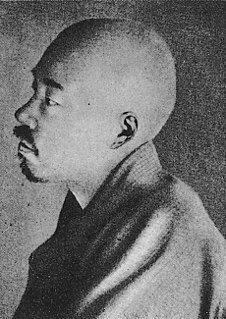
Masaoka Shiki, pen-name of Masaoka Noboru, was a Japanese poet, author, and literary critic in Meiji period Japan. Shiki is regarded as a major figure in the development of modern haiku poetry, credited with writing nearly 20,000 stanzas during his short life. He also wrote on reform of tanka poetry.
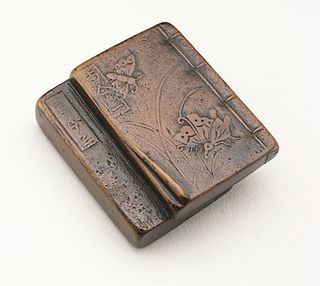
Japanese poetry is poetry typical of Japan, or written, spoken, or chanted in the Japanese language, which includes Old Japanese, Early Middle Japanese, Late Middle Japanese, and Modern Japanese, as well as poetry in Japan which was written in the Chinese language or ryūka from the Okinawa Islands: it is possible to make a more accurate distinction between Japanese poetry written in Japan or by Japanese people in other languages versus that written in the Japanese language by speaking of Japanese-language poetry. Much of the literary record of Japanese poetry begins when Japanese poets encountered Chinese poetry during the Tang dynasty. Under the influence of the Chinese poets of this era Japanese began to compose poetry in Chinese kanshi); and, as part of this tradition, poetry in Japan tended to be intimately associated with pictorial painting, partly because of the influence of Chinese arts, and the tradition of the use of ink and brush for both writing and drawing. It took several hundred years to digest the foreign impact and make it an integral part of Japanese culture and to merge this kanshi poetry into a Japanese language literary tradition, and then later to develop the diversity of unique poetic forms of native poetry, such as waka, haikai, and other more Japanese poetic specialties. For example, in the Tale of Genji both kanshi and waka are frequently mentioned. The history of Japanese poetry goes from an early semi-historical/mythological phase, through the early Old Japanese literature inclusions, just before the Nara period, the Nara period itself, the Heian period, the Kamakura period, and so on, up through the poetically important Edo period and modern times; however, the history of poetry often is different from socio-political history.
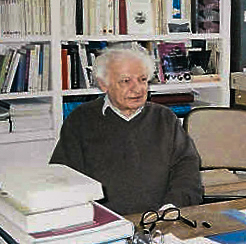
Yves Jean Bonnefoy was a French poet and art historian. He also published a number of translations, most notably the plays of William Shakespeare which are considered among the best in French. He was professor at the Collège de France from 1981 to 1993 and is the author of several works on art, art history, and artists including Miró and Giacometti, and a monograph on Paris-based Iranian artist Farhad Ostovani. The Encyclopædia Britannica states that Bonnefoy was ″perhaps the most important French poet of the latter half of the 20th century.″
Asian literature is the literature produced in Asia.
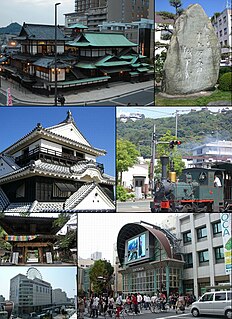
Matsuyama is the capital city of Ehime Prefecture on the island of Shikoku in Japan and also Shikoku's largest city. As of 1 October 2022, the city had an estimated population of 505,948 in 243541 households and a population density of 1200 persons per km². The total area of the city is 429.35 square kilometres (165.77 sq mi).
Haikai may refer in both Japanese and English to haikai no renga (renku), a popular genre of Japanese linked verse, which developed in the sixteenth century out of the earlier aristocratic renga. It meant "vulgar" or "earthy", and often derived its effect from satire and puns, though "under the influence of [Matsuo] Bashō (1644–1694) the tone of haikai no renga became more serious". "Haikai" may also refer to other poetic forms that embrace the haikai aesthetic, including haiku and senryū, haiga, and haibun. However, haikai does not include orthodox renga or waka.
Cor Van den Heuvel is an American haiku poet, editor and archivist.
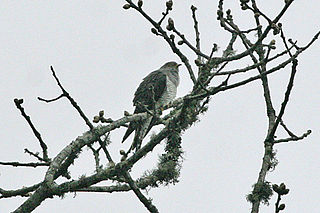
The lesser cuckoo is a species of cuckoo in the family Cuculidae.
Jean-Jacques Origas (1937–2003) was a French academic with expertise in Japanese literature and art. He was a Japanologist, best known more for giving his knowledge to his students rather than for publishing books.
William J. Higginson was an American poet, translator and author most notable for his work with haiku and renku, born in New York City. He was one of the charter members of the Haiku Society of America, and was present at its formation meeting in 1968.
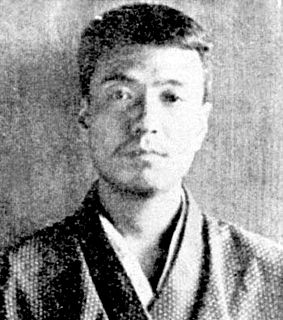
Kyoshi Takahama was a Japanese poet active during the Shōwa period of Japan. His real name was Takahama Kiyoshi (高浜清); Kyoshi was a pen name given to him by his mentor, Masaoka Shiki.
Gania Nishimura is a Japanese poet and an international civil servant.
Hototogisu is a Japanese literary magazine focusing primarily on haiku. Founded in 1897, it was responsible for the spread of modern haiku among the Japanese public and is now Japan's most prestigious and long-lived haiku periodical.
The composition and translation of tanka in English begins at the end of the nineteenth century in England and the United States. Translations into English of classic Japanese tanka date back at least to the 1865 translation of the classic Ogura Hyakunin Isshu ; an early publication of originally English tanka dates to 1899. In the United States, the publication of tanka in Japanese and in English translation acquires extra impetus after World War II, and is followed by a rise of the genre's popularity among native speakers of English.
Hungarian PEN Club is an affiliate of International PEN. The Hungarian Club was established in 1926 by Antal Radó. Early writers associated with the club included Albert Berzeviczy and Jenő Rákosi. Prominent members include Zsolt Harsányi, Miklós Hubay, Dezső Kosztolányi, Sándor Márai, Árpád Göncz, Gábor Görgey, and Zoltán Sumonyi.
The Matsuyama Declarationwas announced in September 1999, reviewing the prospect of world haiku in the 21st century, and the shape that the haiku must then take. The declaration was first drafted by the Coordination Council of Matsuyama in Matsuyama, Ehime on July 18, 1999. The declaration was officially announced at the Shimanami Kaido 99 International Haiku Convention on September 12, 1999. The proceeding of the convention was covered live on the internet to the entire world by the Shiki team in the Matsuyama Information Handling Chamber, and was also broadcast on BS Forum “Declaration of Haiku Innovation” on October 2, 1999.

Kawahigashi Hekigotō, birth name Kawahigashi Heigorō, was a Japanese poet and modern pioneer of the haiku form.
References
- ↑ SHlMANAMI KAIDO99,International Haiku Convention
- ↑ International Haiku Convention 2000 Masaoka Shiki International Haiku Awards
- ↑ International Haiku Convention 2002 Masaoka Shiki International Haiku Awards
- ↑ International Haiku Convention 2004 Masaoka Shiki International Haiku Awards
- ↑ International Haiku Convention 2009 Masaoka Shiki International Haiku Awards
- International Haiku Awards Announcement of Awardees for 2008
- Yves Bonnefoy (translated by Koji Kawamoto) and Description of Haiku and short form of poems and French Poets (translated by Toru Shiga) (『Shincho』 December 2000)